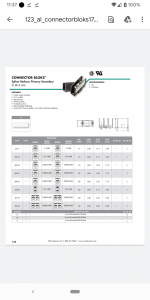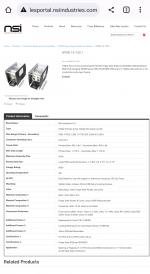Mr. Serious
Senior Member
- Location
- Oklahoma, USA
- Occupation
- Electrical Contractor
Are there terminal blocks that are rated for use with un-fused service conductors? I recall seeing a somewhat-new code provision requiring that such blocks be specifically rated for it, when used in this way. But I can't remember the exact wording or where in the code to find it.
As a new contractor last year, I built a service with two parallel 350MCM aluminum conductors per phase through the underground conduit, which transitioned to two 250MCM copper conductors via terminal blocks mounted in a box below the main panel. NSI ALP2P2 connector bloks. The reason was to save money on the 130-foot long underground wires while keeping the main wires into the panel small enough to fit into its lugs. But later I thought it maybe would have been a lot easier to order custom lugs for the panel.
So, now I'm working on another large new service. Service equipment for these things sometimes can't be ordered on any reasonable time frame. So, we're working with the only panel that was available. The panel comes with lugs rated for (2) parallel runs of up to 600MCM, which would require copper to get the full 800 amps, but the customer wants to mainly use aluminum to save money, the power company diagrams show a splice in the main wires inside the CT cabinet anyway. This time, some way is required to splice between (4) or (6) smaller aluminum wires to (2) larger copper ones for each phase. I was looking at the NPDB-14-750-1, but I want to do things right this time, and I think all connector blocks like this require a fuse ahead of the block. So, what do I use for connectors for unfused service wires? Polaris lugs?
Or, is it more prudent to check with the power company to see if the splice in the CT cabinet is really required, and if not, see if different main lugs can be ordered for the panel?
As a new contractor last year, I built a service with two parallel 350MCM aluminum conductors per phase through the underground conduit, which transitioned to two 250MCM copper conductors via terminal blocks mounted in a box below the main panel. NSI ALP2P2 connector bloks. The reason was to save money on the 130-foot long underground wires while keeping the main wires into the panel small enough to fit into its lugs. But later I thought it maybe would have been a lot easier to order custom lugs for the panel.
So, now I'm working on another large new service. Service equipment for these things sometimes can't be ordered on any reasonable time frame. So, we're working with the only panel that was available. The panel comes with lugs rated for (2) parallel runs of up to 600MCM, which would require copper to get the full 800 amps, but the customer wants to mainly use aluminum to save money, the power company diagrams show a splice in the main wires inside the CT cabinet anyway. This time, some way is required to splice between (4) or (6) smaller aluminum wires to (2) larger copper ones for each phase. I was looking at the NPDB-14-750-1, but I want to do things right this time, and I think all connector blocks like this require a fuse ahead of the block. So, what do I use for connectors for unfused service wires? Polaris lugs?
Or, is it more prudent to check with the power company to see if the splice in the CT cabinet is really required, and if not, see if different main lugs can be ordered for the panel?



